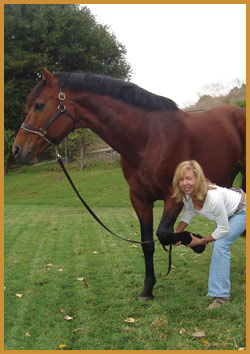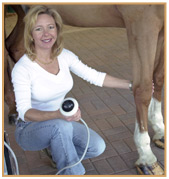
Jenny E. Johnson, V.M.D. Calabasas, CA (818) 809-SHWV (7498) (818) 878-9458 - fax equineshockwave.com |
||
| In This Issue | ||
• Main Story • Shockwave Q&A • Tell a Friend • Previous Issues • About Dr. Johnson |
||
| Ask Dr. Johnson | ||
Dr. Johnson is available to answer any questions you may have. Simply click here to email your questions directly to her. |
||
| Tell a Friend | ||
Share a wealth of veterinary knowledge with your friends and colleagues. Click here to forward this email. |
||
| Previous Issues | ||
April 2008 - click here June 2008 - click here |
||
 |
| September 2008 | |
| Shockwave Therapy and the Equine Foot |
|
 Lameness in the foot Lameness resulting from injury to or disease of the foot is very common in the horse. Lameness localized to the foot by a posterior digital nerve block (“heel block”) may include, but is not limited to, pathology or injury to the structures associated with the navicular apparatus (navicular bone, the collateral ligaments of the navicular bone, the distal sesamoidean impar ligament, the navicular bursa, the deep digital flexor tendon, and the distal digital annular ligament), collateral ligaments of the coffin joint, the coffin bone, laminitis, and solar pain. Historically, “navicular disease” or “navicular syndrome” has been one of the most common diagnoses given when lameness is isolated to the foot. Treatment of many disorders of the foot has been limited in the past largely to corrective shoeing and the administration of non-steroidal anti-inflammatory medications. The results of such treatments were frequently inadequate. With the advent and availability of more advanced diagnostic methods such as nuclear scintigraphy (bone scan), digital radiography, digital ultrasound, and magnetic resonance imaging (MRI) veterinarians are now able to reach a more exact diagnosis for the source of pain in the foot. This allows for a much more specific approach to the treatment of foot lamenesses. Using shockwave therapy to treat the foot Shockwave therapy is a very important tool in the treatment of many lamenesses originating in the foot. With images from an MRI and/or ultrasound, damage to one or more of the structures within the hoof may be identified. Shockwave therapy can then be targeted to the specific area of injury. This can be instrumental in increasing the circulation to the injured area and in stimulating stem cells and other healing factors to come to this area, significantly advancing the veterinarian’s ability to treat these conditions. Used in combination with the more traditional options of corrective shoeing, rest, and anti-inflammatories, the prognosis for healing and return to function can frequently be improved substantially. Shockwave Therapy has been used successfully to treat navicular syndrome. Current research has shown that 2/3 of horses with lameness due to navicular syndrome will improve approximately 1 degree of lameness when treated with shockwave therapy. This can lead to a significantly improved prognosis for those horses suffering from navicular syndrome, particularly when shockwave therapy is used in conjunction with more traditional therapies. What problems in the foot can be treated with shockwave? • Impar ligament • Collateral ligaments of the navicular bone • Navicular bone edema • Navicular bursa inflammation • Navicular disease • Deep digital flexor tendon tears or lesions • Medial and Lateral Collateral ligaments of the coffin joint What is the procedure? In order to treat the structures inside the hoof and in the area of the navicular bone, the shockwaves will be directed through the bulbs of the heels and frequently through the frog. In order for the shockwaves to penetrate through the frog effectively, the shoe needs to be removed and the foot soaked overnight. This is usually accomplished by either using a soaking boot, or wrapping a wet tack sponge onto the frog with vetrap and duct tape. The frog is then pared down until it is fairly soft and spongy. This allows the shockwaves to penetrate from the probe head, through the frog and to the desired site. With diagnostic imaging information, the shockwaves can be directed to the specific area of injury. Shockwaves will not penetrate the hoof wall, and for this reason, shockwave therapy is not an effective treatment for laminitis. When treating collateral ligament injuries, the shockwave probe is directed over the collateral ligament just above the coronet band and also directly through the coronet band. The protocol for treatment will vary with each horse, depending on the location and severity of injury. The treatment is done with the horse standing and lightly sedated. Typically, a series of three treatments spaced at about 3 week intervals will be performed. In the case of more severe or longstanding injuries, additional treatments may be necessary. Are all shockwave machines the same? As always, it is important to remember that not all shockwave machines are the same. There have been a number of machines marketed as shockwave machines that do not actually produce a true shockwave, but rather a ballistic or radial wave. The physics of this type of wave are completely different from those of a true shockwave. This is important information when treating injuries inside the hoof because the energy generated with a radial machine will not penetrate adequately inside the hoof either through the heels or through the frog. The equipment used by Dr. Johnson is a Versatron, manufactured by Sanuwave. This is a true focused shockwave generator and is the same equipment currently being used in 18 veterinary teaching hospitals. |
|
| Shockwave Q&A | |
Q: My horse does not have any specific lesions in his feet, but is frequently “foot sore”. Will shockwave help? A: As always, it is best to try and find the source of the pain first, but there are some horses that seem to have non-specific foot soreness. Many of these horses will become more comfortable with shockwave therapy of their feet. This can be a useful aid in helping to keep an older competitive horse comfortable and able to do his job more happily. Q: Can shockwave therapy be used to treat a foot abscess? A: Generally foot abscesses can be treated relatively easily through more conservative treatment such as soaking, draining the abscess, and wrapping the foot with a drawing agent. Shockwaves will not penetrate the sole of the hoof to any significant degree and would therefore be of minimal use in treating most foot abscesses. In the case of a penetrating wound through the frog, shockwave therapy could potentially be used as an adjunct to the traditional therapy in efforts to speed the healing and decrease the infection associated with such a wound. |
|
| About Dr. Johnson | |
|
|
818-809-7498 | www.equineshockwave.com © 2008-2010 Oakhill Shockwave & Veterinary Chiropractic. All rights reserved. eNewsletter design by EquestriSol |
|
